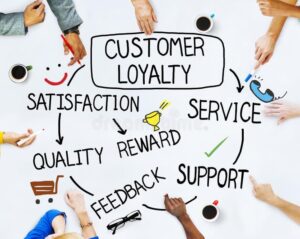
Customer Retention Strategies: The Key to Building Long-Term Success in Retail
In today’s competitive retail environment, attracting new customers is only part of the equation for long-term growth and success. While customer acquisition is essential, it’s customer retention — keeping existing customers coming back — that truly defines sustainable business success. Research shows that retaining customers is often more cost-effective and profitable than constantly seeking new ones. With fierce competition across online and offline spaces, building a loyal customer base has become more important than ever.
In this article, we’ll explore why retaining customers is such a challenge, examine the key factors that contribute to customer loyalty, and provide actionable strategies for developing a strong customer retention plan.
Why Customer Retention Is So Challenging
Customer retention presents a unique set of challenges for both small and large retailers. In an age where consumers have an abundance of choices at their fingertips, retailers need to work hard to keep customers engaged and satisfied. Here are a few key reasons why retaining customers can be particularly difficult:
Increased Customer Expectations: Modern customers expect fast shipping, seamless online shopping experiences, and exceptional customer service. Meeting these expectations requires substantial resources and constant improvements, which can be hard to maintain.
Rising Competition: With the growth of e-commerce and digital marketing, customers are continuously exposed to offers from competitors. Retaining customers requires retailers to keep their brand at the forefront and provide ongoing value.
Price Sensitivity: As more retailers offer discounts and incentives, customers may be less likely to remain loyal to a single brand. Businesses must find ways to compete beyond price alone to retain their customers.
Customer Fatigue: Loyalty programs and promotional emails, while effective, can become overwhelming to customers if not carefully managed. Finding the right balance in customer communication is essential.
Cost of Personalization: Customers expect personalized experiences, but implementing tailored recommendations, communications, and rewards requires technology and resources, which can strain smaller businesses.
The Value of Customer Retention
The benefits of customer retention are significant, making it well worth the effort. Here are some compelling reasons why businesses should prioritize customer loyalty and retention:
- Increased Revenue: Repeat customers tend to spend more over time, and they’re also more likely to try new products or services offered by the business.
- Reduced Marketing Costs: Acquiring new customers often costs five times more than retaining existing ones. By focusing on customer retention, businesses can lower their overall marketing expenses.
- Word-of-Mouth Referrals: Satisfied customers are more likely to recommend a business to friends and family, bringing in new customers through free, authentic referrals.
- Higher Customer Lifetime Value (CLV): Retained customers contribute to a higher CLV, which measures the total revenue a customer generates for the business over their lifetime.
Effective Customer Retention Strategies
Implementing a customer retention strategy that focuses on loyalty, engagement, and superior service can help businesses build strong customer relationships and boost retention rates. Here’s how to get started:
1. Develop a Loyalty Program That Offers Genuine Value
Loyalty programs can be powerful, but they need to be carefully designed to provide real value. Instead of only offering discounts, consider a points-based program that rewards customers for frequent purchases, reviews, or referrals. For example, a tiered loyalty program can incentivize customers to reach higher spending levels for exclusive perks, creating a sense of achievement and exclusivity.
2. Focus on Exceptional Customer Service
Customer service is a cornerstone of customer retention. Ensure your team is well-trained in handling inquiries, complaints, and returns in a friendly and efficient manner. Prompt responses to customer concerns, either online or in-store, can make a big difference in customer satisfaction. Consider offering live chat support on your website to address customer queries in real-time, creating a seamless and satisfying experience.
3. Personalize the Customer Experience
Customers are more likely to return to brands that treat them as individuals rather than just transactions. Use CRM tools to personalize communications, sending tailored product recommendations, birthday discounts, and exclusive offers based on purchase history. Personalization not only enhances the shopping experience but also reinforces a connection between the customer and the brand.
4. Engage with Customers on Social Media
Social media is a valuable tool for connecting with your audience and fostering brand loyalty. Regularly interact with customers by responding to comments, sharing user-generated content, and offering behind-the-scenes glimpses of your business. Engaging with customers on social media helps build a community around your brand, where customers feel valued and included.
5. Implement an Easy and Transparent Return Policy
A hassle-free return policy shows customers that you stand by your products and care about their satisfaction. Make your return policy clear and easy to find, and consider offering free returns where feasible. A generous return policy can boost customer confidence, making them more likely to purchase again.
6. Offer Exclusive Member-Only Benefits
For retailers with loyalty programs or memberships, providing exclusive benefits can enhance loyalty. Offer members access to early sales, special discounts, or limited-edition products. This kind of VIP treatment can create a sense of exclusivity that encourages customers to stay loyal and feel valued.
Measuring Customer Retention Success
To understand if your customer retention efforts are paying off, it’s essential to track certain key metrics. Here are a few metrics to focus on:
- Customer Retention Rate (CRR): This metric shows the percentage of customers who continue to do business with you over a given period.
- Repeat Purchase Rate: This measures the percentage of customers who make more than one purchase, indicating the success of your retention strategy.
- Customer Lifetime Value (CLV): CLV reflects the total revenue a customer will generate for your business, allowing you to measure the effectiveness of your retention efforts.
- Net Promoter Score (NPS): NPS measures customer satisfaction and loyalty based on how likely customers are to recommend your business to others.
The Benefits of a Strong Customer Retention Strategy
Retailers who prioritize customer retention are often the ones who experience long-term success. Building a loyal customer base creates a steady stream of revenue and contributes to a positive brand reputation. When customers feel valued and engaged, they’re more likely to continue supporting your business and even become advocates, helping you attract new customers through word-of-mouth.
In conclusion, while attracting new customers is crucial, focusing on customer retention is often the most cost-effective and impactful way to grow a retail business. By implementing loyalty programs, prioritizing customer service, and creating personalized experiences, businesses can build long-lasting relationships that drive sustainable success.



